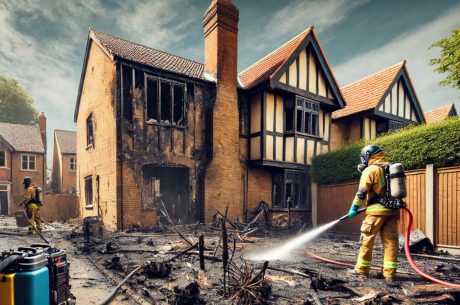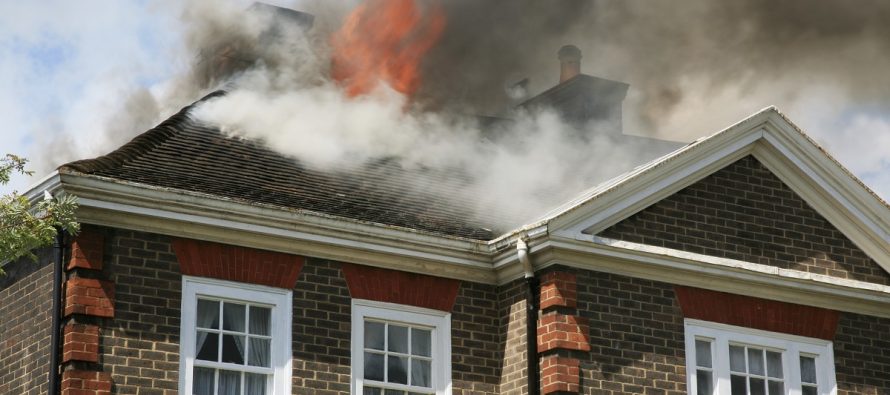Table of Contents
Preventing Christmas Tree Fires
The holiday season is a time for joy, family gatherings, and festive decorations—but it’s also a time when the risk of house fires increases. One of the most overlooked fire hazards during the holidays is the Christmas tree. While a beautifully lit tree is the centerpiece of holiday décor, it can quickly turn dangerous if proper precautions aren’t taken. In fact, the National Fire Protection Association (NFPA) reports that Christmas tree fires cause hundreds of home fires annually, leading to significant property damage and sometimes even tragedy.
To ensure your holidays remain merry and bright, it’s crucial to understand the common causes of Christmas tree fires and take steps to prevent them. From choosing the right tree to managing electrical decorations safely, a little preparation can make all the difference. Read on for practical tips to keep your home and family safe this holiday season.
Christmas Tree Fire Statistics in the US
Christmas tree fires, though uncommon, can lead to severe consequences when they do occur. In the United States, an average of 160 home fires each year are caused by Christmas trees. While this number represents less than 0.1% of all reported home fires, the impact of these incidents is often disproportionately high. The combination of dry, flammable trees and holiday lighting can create the perfect conditions for a fast-spreading fire.
These fires cause an average of two deaths and 12 injuries annually, making them particularly dangerous despite their rarity. In addition to personal tragedy, Christmas tree fires lead to significant financial loss, with approximately $10 million in property damage reported each year. The intensity and speed of these fires often result in extensive destruction, as a single dry tree can fully engulf a room in flames in less than 30 seconds.
Electrical failures or malfunctions are the leading cause of Christmas tree fires, accounting for nearly 44% of incidents. Heat sources placed too close to the tree, such as candles or space heaters, are responsible for about 25% of these fires. Natural trees are involved in the majority of cases, particularly when they are not adequately watered and allowed to dry out.
The risk of Christmas tree fires peaks on and around Christmas Day and New Year’s Day, coinciding with holiday celebrations and the increased use of decorative lighting. These statistics highlight the importance of taking preventive measures to ensure a safe holiday season. Simple actions such as keeping your tree well-watered, inspecting electrical decorations, and positioning your tree away from heat sources can make a significant difference in reducing the risk of a fire.
Causes of Christmas Tree Fires
Christmas trees add warmth and cheer to the holiday season, but they can also become a dangerous fire hazard if not handled with care. Understanding the common causes of Christmas tree fires can help you take proactive measures to keep your home safe. Here are some of the primary culprits behind these seasonal incidents:
- Dry Trees
A dry tree is highly flammable, and even a small heat source can ignite it. Natural Christmas trees that are not adequately watered can dry out quickly, making them prone to catching fire. - Faulty or Overloaded Lights
Damaged or frayed wires, overloaded electrical outlets, and the use of non-LED lights can create sparks or excessive heat, increasing the risk of a fire. - Proximity to Heat Sources
Placing your tree too close to fireplaces, space heaters, radiators, or candles can quickly turn a festive centerpiece into a fire hazard. - Unattended Lights
Leaving Christmas tree lights on overnight or when no one is home increases the chance of an electrical malfunction sparking a fire. - Improper Candle Placement
Decorative candles near or on the tree can pose a significant risk, especially if branches come into contact with an open flame. - Combustible Decorations
Flammable ornaments or decorations made from paper, fabric, or untreated wood can catch fire easily, especially when combined with other ignition sources.
Being aware of these causes is the first step toward a safer holiday season. By following proper tree care and safety measures, you can reduce the risk and enjoy a worry-free celebration.
Safety Tips to Prevent Christmas Tree Fires
The holiday season is a time for joy, and ensuring your Christmas tree is safe can help keep the celebrations worry-free. Here are essential safety tips to prevent Christmas tree fires:
- Choose a Fresh Tree
If opting for a real tree, select one with vibrant green needles that don’t fall off when touched. A fresh tree is less likely to dry out and catch fire. - Keep the Tree Hydrated
Water your tree daily to prevent it from drying out. A well-watered tree is much less flammable than a dry one. - Use Flame-Resistant Decorations
Choose decorations labeled as flame-retardant or non-combustible to reduce fire risks. Avoid using materials like paper or untreated fabric near lights. - Inspect Lights Carefully
Before decorating, check all light strings for frayed wires, broken bulbs, or loose connections. Replace damaged lights and use LED options, which emit less heat. - Avoid Overloading Outlets
Plug lights into surge protectors and avoid overloading electrical outlets. Use a timer or smart plug to ensure lights are not left on overnight or when you’re not at home. - Place the Tree Away from Heat Sources
Keep your tree at least three feet away from fireplaces, radiators, candles, or space heaters. Ensure the tree is set up in a stable location where it won’t tip over. - Never Use Candles on or Near the Tree
Although candles add a cozy ambiance, they should never be placed on or near a Christmas tree. Opt for battery-operated flameless candles instead. - Dispose of the Tree Promptly
Once the holiday season ends or the tree begins to dry out, remove it from your home. Don’t leave a dry tree inside or near your house, as it becomes a significant fire hazard. - Have a Fire Extinguisher Nearby
Keep a fire extinguisher easily accessible and ensure family members know how to use it in case of an emergency. - Test Your Smoke Alarms
Ensure your smoke detectors are in working order before setting up your tree. Early detection is key to minimizing damage in case of a fire.
By following these safety tips, you can enjoy the beauty of your Christmas tree without compromising the safety of your home and loved ones. Stay safe and have a happy holiday season!




 PuroClean of Auburn
PuroClean of Auburn